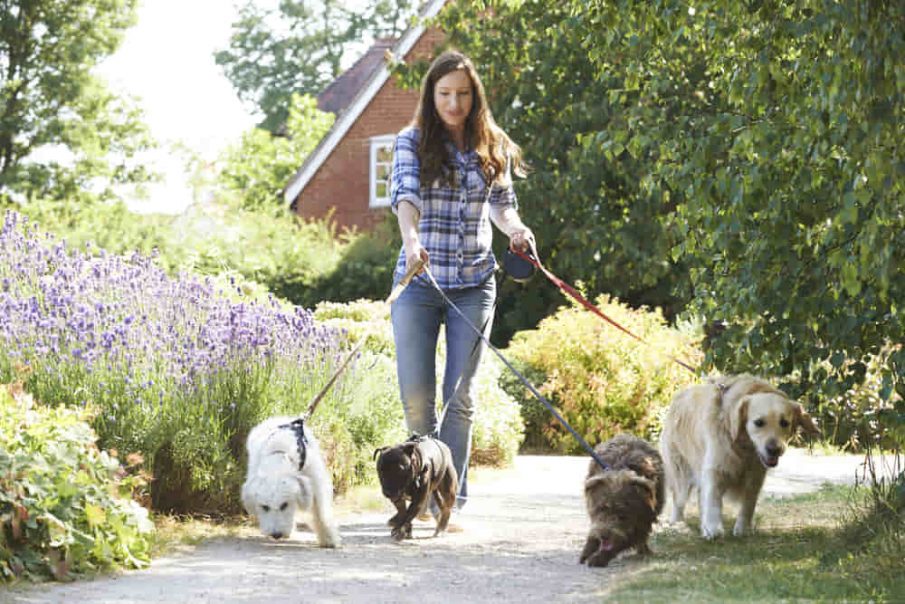Starting a dog walking business might not seem to difficult on the surface, but like any business, it needs planning and research if you want to reach your customers and gain business. Money.co.uk business insurance expert Cam Jaques gives his top tips for starting up a dog walking business.
Do Your Research
Begin by researching your local market. Understand the demand for dog walking services in your area, your competition, and the rates they charge. Develop a solid business plan that outlines your goals, target market, pricing structure, and marketing strategies. You may also want to look into how to register a company depending on your goals and where you want to take the business.
Get Dog Walking Insurance
Dog walking insurance is an important part of setting up a dog walking business, as it helps to protect your business and the dogs you look after. Dog walking is not a risk-free business and there is a lot of emotional and financial responsibility attached to it.
The key to dog walking insurance is public liability, which includes accident and injury cover. This covers dog walkers if the worst happens, for example if a dog is lost or injured during your care or if a dog causes an injury or accident to someone or someone else’s property.

Ensure You Choose The Right Cover For You
Identify the different levels of cover available to decide how much protection you need. It’s important to consider all aspects of the job, including whether you visit clients’ houses or use your own car.
You might also need employers’ liability insurance in your policy if you hire any staff. It’s also worth considering personal accident cover in case you suffer a injury during a walk or business equipment cover if you have specialist leads or dog toys. This can also cover the technology you use to manage booking with your clients, for example a laptop or phone. Speaking of tech, if you hold personal details of your clients online, then cyber insurance might also be useful.
Check Your Policy
Dog walking insurance policies will not cover everything, including:
- Any animal scheduled under the Dangerous Wild Animals Act (DWAA)
- Any excess applicable
- Walking more dogs than is specifically outlined in the original policy
Hence, make sure you always check your own policy documents thoroughly for a full list of exclusions.
Legal Considerations
Register your business, choose a suitable business name, and determine the legal requirements for operating a dog walking service in your area. This might include getting any necessary licenses, permits, or insurance coverage.
Training and Experience
Gain relevant knowledge and experience in handling different dog breeds and temperaments. Consider taking dog training courses, first aid classes, and obtaining certifications in pet care to build your credibility and expertise.
Safety First
Prioritise the safety of the dogs in your care. Ensure that you have a sturdy leash and collar, know basic dog body language, and have a plan for handling emergencies. Carry a basic first aid kit and have a list of emergency contacts, including the dogs’ owners and local veterinarians.
Building Trust
Establish trust with your clients by being reliable, punctual, and consistent. Communicate effectively with pet owners, provide updates on walks, and address any concerns promptly. Building strong relationships with both dogs and their owners is key to your success.
Customised Services
Tailor your services to meet the specific needs of each dog. Some dogs might require longer walks, individual attention, or specific care instructions. Offering personalised services can set you apart from competitors and make your clients feel valued. To ensure you’re still making healthy profits from these services, use earned value management software to track your budget against the time taken to complete them, ensuring you aren’t overspending unnecessarily.
Marketing and Branding
Create a professional brand identity that reflects your values and services. Develop a user-friendly website, use social media platforms to showcase your work, and consider creating informative content about dog care to attract potential clients.
Networking
Build a network within the local pet community. Partner with veterinarians, pet stores, groomers, and other pet-related businesses to get referrals and increase your visibility. Attending local dog-related events can also help you connect with potential clients.
Time Management
Efficiently manage your schedule to accommodate multiple clients and their preferred walking times. Use scheduling tools or apps to keep track of appointments, routes, and special requests.
Continual Learning
Stay updated on the latest trends and advancements in dog care and walking techniques. Attend workshops, read books, and follow industry blogs to enhance your skills and provide the best possible service to your furry clients.
Remember that starting a dog walking business requires dedication, patience, and a genuine love for dogs. By providing excellent care, building strong relationships, and continually improving your skills, you’ll be well on your way to a successful venture.






